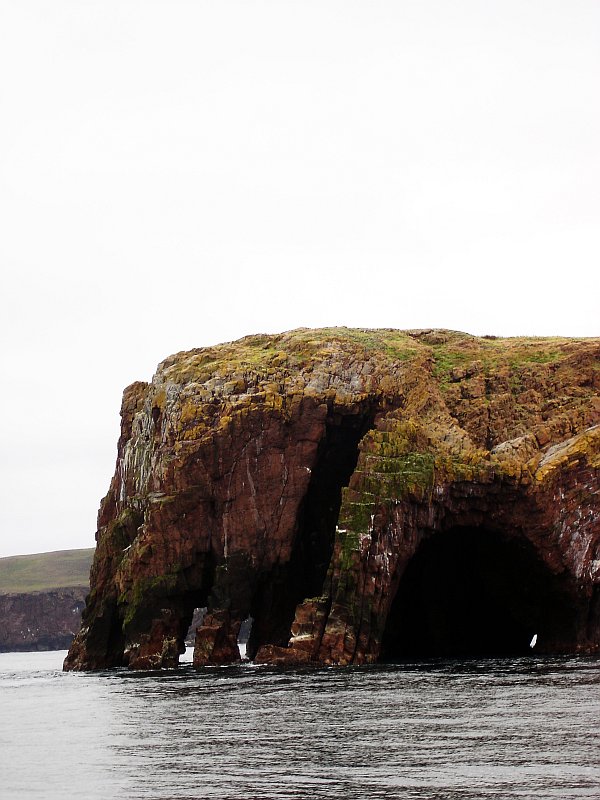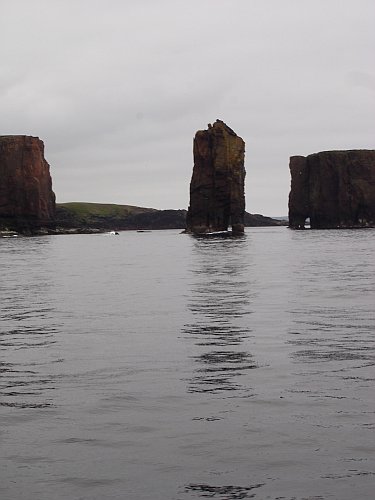Welcome to Papa Stour
This rugged island lies off the west coast of Shetland’s mainland. Some of the most impressive coastline in Shetland can be seen here, including caves, arches, stacks and skerries. For walkers, wildlife enthusiasts and those interested in archaeology, Papa Stour has much to offer.
 Cliffs at Papa Stour
Cliffs at Papa Stour
 Papa Stour can be reached by plane from Tingwall Airport, 7 miles outside Lerwick. Alternatively, the ferry leaves from West Burrafirth and takes about 45 minutes to reach Housa Voe on the east side of Papa Stour. The ground here is low lying and fertile compared to the moorland and steep vertical cliffs that dominate most of the west coast. This is also the centre of the population where about 13 people now live. For most islanders crofting is a way of life.
Papa Stour can be reached by plane from Tingwall Airport, 7 miles outside Lerwick. Alternatively, the ferry leaves from West Burrafirth and takes about 45 minutes to reach Housa Voe on the east side of Papa Stour. The ground here is low lying and fertile compared to the moorland and steep vertical cliffs that dominate most of the west coast. This is also the centre of the population where about 13 people now live. For most islanders crofting is a way of life.
Although the ferry to Papa Stour carries cars, there is little need of one as there is only one short road on the island and the best way to see the sights is on foot.
History
The name Papa Stour is believed to have been given to the island by the Vikings. Papey Stóra in Old Norse means the big island of priests, and refers to a community of Celtic missionary priests that lived on Papa Stour, perhaps as early as the 6th century.
Papa Stour became an important area for Norsemen, providing both a strategic base and safe haven for their boats. By the end of the 13th century the island had become a Norwegian royal farm, the personal property of King Hakon. Although Shetland was pledged to Scotland in 1469 the Lairds of Norway kept their estates on Papa Stour until well into the17th century.
During the 18th century two lairds from the mainland, Thomas Gifford of Busta and Arthur Nicolson of Lerwick, divided Papa Stour between them and the island has remained part of these estates until the present day.
Archaeology
Papa Stour is full of prehistoric remains, the evidence of settlement back through the ages to Neolithic and Bronze Age times, 5000 years ago. In the historic era, Papa Stour was the source of the oldest surviving written document from Shetland. It is known as the 1299 document and contains allegations of corruption made by one of the islanders.
Geology
The west coast of Papa Stour contains some of the most exposed coastline in the British Isles. Exposed to the full force of the Atlantic Ocean the island’s Devonian age rocks have been carved into towering vertical cliffs, stacks and arches. Bands of volcanic ash (ignimbrite) and orange solidified lava (rhyolite) can be seen running through the rock faces.
At Lamar Banks at the south side of the entrance to Housa Voe, a bed of calcareous mudstone containing broken remains of fossil fish has been discovered. Inland, ridges of glacial moraine – huge boulders carried by glaciers – run across the island, marking the edge of an ancient ice sheet.
Flora
The island is divided by a hill dyke that separates the fertile in-by land from the moorland of the scattald or common grazings to the west. In the past, turf and peat from the scattald was removed and used by the islanders to provide fertiliser and fuel. This has produced a unique ‘scalped’ heathland of short wind-clipped vegetation growing on gravelly sub-soil.
Today the heathland is covered with a variety of plants including Ling, Thyme, Mountain Everlasting, Spring Squill, Plantain, Heath-spotted Orchid and Woolly Hair Moss. In contrast, maritime species such as Sea Pinks and Campions thrive in the salty sea air along the cliff tops.
The open scattald provides a perfect environment for ground nesting birds such as Ringed Plovers, Arctic Skuas and Arctic Terns which have become regular visitors. Papa Stour is now recognised as an internationally important area for the large number of Arctic Terns that nest on the island in the summer months. Other sea birds are also attracted to Papa Stour.
The rocky coastline and cliffs provide suitable nesting spots for 15 species of sea birds to breed. These include Fulmar, Shag, Guillemot, Black Guillemot, Razorbill, Great Black-backed Gull and Kittiwake.
Sea Mammals
Seals are regular visitors to the shores of Papa Stour, hauling themselves out on rocks in the geos along the west coast. Common Seals come ashore to pup in June and July. They are easily recognisable, lying on the rocks in a characteristic crescent shape with their heads and tails lifted high. The Grey Seals are much larger and have long distinctive roman noses. In October the furry white coats of the Grey Seal pups can be seen dotted across the beaches. Much harder to see are Harbour Porpoises and occasional pods of Killer Whales that swim past Papa Stour. Keep a careful look out to sea as you walk around as you never know when one of these animals might appear. The low rocky shores of the islands and voes provide a home for another sea mammal – the elusive Otter. The kelp forests that grow in shallow waters hide many small fish for them to feed on. But tread softly because otters are very shy creatures.
Exploring Papa Stour
On the approach to Papa Stour from West Burrafirth the ferry passes Breis Holm, where you will get your first glimpse of the island’s impressive sea caves. At the foot of Breis Holm a large tunnel cuts right through the holm. In calm weather it is possible to travel through the tunnel by boat.
The tallest of the stacks that cluster around the entrance to Housa Voe, is known as Muckle Fru or Maiden Stack. It was here that the only daughter of a Norwegian Lord was imprisoned by her father for refusing to agree to an arranged marriage. She had given her heart instead to a humble fisherman who, legend has it, rescued her from her solitary confinement on the stack with the help of his friends. The two lovers, reunited once more, fled the island together.
 Sea Stacks
Sea Stacks
 Behind the beach at Housa Voe are the remains of Ting, believed to be a site where Norse assemblies were held. It is reputed that Lord Thorvald Thoresson, the man accused of corruption in the 1299 document, fought and won a duel within this circle.
Behind the beach at Housa Voe are the remains of Ting, believed to be a site where Norse assemblies were held. It is reputed that Lord Thorvald Thoresson, the man accused of corruption in the 1299 document, fought and won a duel within this circle.
Excavations in the 1970s and 1980s at Da Biggins, alongside the road just before the kirk, uncovered the foundations of a medieval Norse house. The remains of wooden floors suggest that this was once a very important building. An interpretation board at the site gives more details of the findings.
Continuing past the kirk and primary school, the road leads to the airstrip and the open scattald. To the south you will find the remains of several Neolithic burial chambers known as heel-shaped cairns because of their shape when viewed from above.
The remains of more recent buildings can also be seen here. Suspected leprosy sufferers from the west mainland used to be sent to live in isolation in the huts whose remains you can see on Hill o Fielie. To survive, they relied on the islanders to leave food for them by the dyke. However, it is now thought more likely that these people suffered from malnutrition or elephantiasis rather than Leprosy.
The small stone buildings around Dutch Loch are good examples of horizontal water mills. Originally these were two story buildings with turf roofs. They were built into banks to give access to the upper floor where the millstone was sited. Many were still in use on Papa Stour in the early years of the 20th century.
To the west of Hamna Voe, the island’s spectacular western cliffs come into view, carved with arches and caves and punctuated with stacks and skerries. Two large holes, set back slightly from the cliff edge, drop through the roof of perhaps the most famous of the Papa Stour caves, known as Kirstan Hol. Look down through the hole and you can see waves breaking on the beach at the back of the cave, but take care, it’s a long way down!
Nowhere on the island is the power of the sea more evident than in the three legged Aesha Stack, Aesha Head, pierced by the Hol o Burri Geo, and the sea caves that penetrate Fugla and Leera Skerries.
The waves do not always have their way though and to the north of Leera Skerry the solitary Snolda (whose name comes from the Old Norse word for a pinnacle) reaches precariously out of the sea, with waves crashing around the base and boulders balanced on top.
Virda Field is the highest point on Papa Stour, providing a panoramic view of the island. To the north west the tips of the Vee Skerries can be seen, just above the sea surface. From this distance they look small, but the shallow baas (submerged reefs) reach out much further and have proved treacherous on many occasions.
This was the scene in December 1977 of Papa Stour’s most recent shipwreck when the Elinor Viking was blown into the Vee Skerries, the rocks tearing a large hole in her side. Fortunately the crew were rescued, but the event prompted the building of the lighthouse on the skerries which is clearly visible from Papa Stour.
In contrast to the rugged coastline of the west, the sheltered voes along the north coast, West Voe and Culla Voe provided shelter for 19th century herring fishing stations. Before the advent of refrigeration, herring needed to be processed quickly and packed in salt to preserve them for export to Europe. Herring stations were set up close to the fishing grounds to speed the process and herring gutters and packers came to work in the island from all over Shetland and even mainland Britain.
Some Useful Information
| Ferry Booking Office: | Tel: 01595 810460 |
| Air Booking Office: | Tingwall Airport, Tel: 01595 840246 |
| Public Telephone: | Hurdiback |
| Medical Assistance: | Waas (Walls) Surgery, Tel: 01595 809352 |


